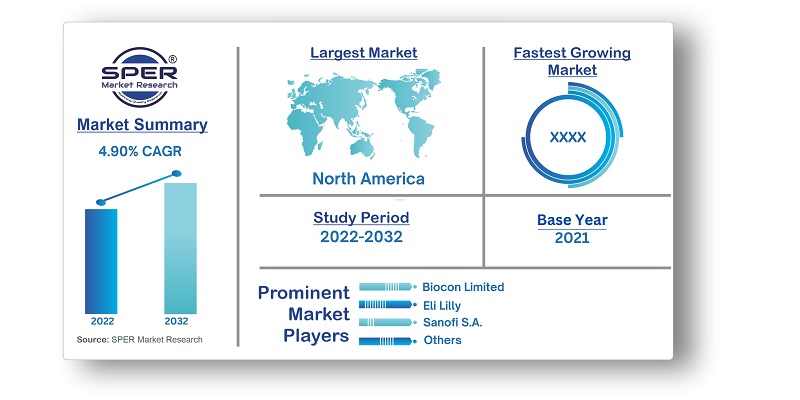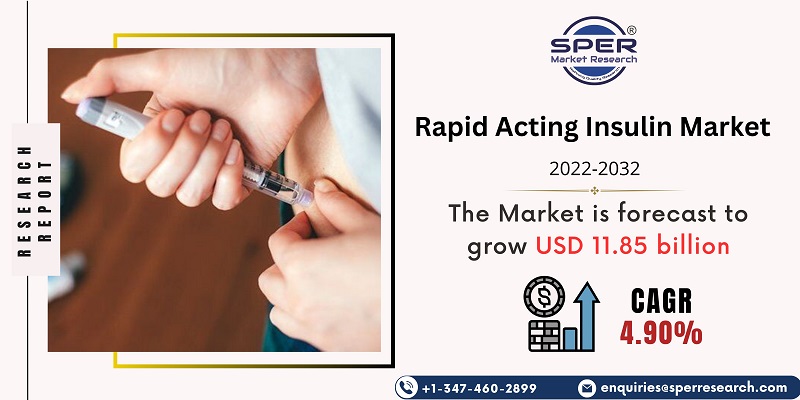
Rapid Acting Insulin Market Growth, Size, Trends, Demand, Revenue, Share and Future Scope
Global Rapid Acting Insulin Market Size- By Product, By Indication, By Distribution Channel- Regional Outlook, Competitive Strategies and Segment Forecasts to 2032
| Published: Nov-2022 | Report ID: PHAR2210 | Pages: 1 - 243 | Formats*: |
| Category : Pharmaceutical | |||
- Increasing prevalence of diabetes: The rising global incidence of diabetes, particularly type 1 and type 2 diabetes, is driving the demand for rapid-acting insulin as an essential treatment option.
- Technological advancements: Continuous advancements in insulin delivery systems, such as insulin pens and pumps, are improving the convenience and accuracy of insulin administration, thereby boosting the market growth.


| Report Metric | Details |
| Market size available for years | 2019-2032 |
| Base year considered | 2021 |
| Forecast period | 2022-2032 |
| Segments covered | By Product, By Indication, By Distribution Channel |
| Regions covered | North America, Asia-Pacific, Latin America, Middle East & Africa and Europe |
| Companies Covered | Biocon Limited, Eli Lilly, Sanofi S.A., Geropharm, Wockhardt Ltd., Novo Nordisk A/S, ManKind Corporation, Adocia, Gan & Lee Pharmaceuticals Co. Ltd., Merck & Co. Inc. and Others. |
- Clinics and Hospitals
- Diabetes Clinicians and Specialists
- Diagnostic Laboratories
- Government Health Departments
- Pharmacy Chains and Retailers
- Research Institutes and Academic Institutions
- Self-care Individuals with Diabetes
- Wholesale Distributors and Suppliers
- Others
| By Indication: |
|
| By Distribution Channel: |
|
- Global Rapid Acting Insulin Market Size (FY’2022-FY’2032)
- Overview of Global Rapid Acting Insulin Market
- Segmentation of Global Rapid Acting Insulin Market By Product (Lispro Insulin, Aspart Insulin, Glulisine Insulin)
- Segmentation of Global Rapid Acting Insulin Market By Indication (Type 1 Diabetes and Type 2 Diabetes)
- Segmentation of Global Rapid Acting Insulin Market By Distribution Channel (Hospital Pharmacies, Drug Stores and Retail Pharmacies, Online Stores)
- Statistical Snap of Global Rapid Acting Insulin Market
- Expansion Analysis of Global Rapid Acting Insulin Market
- Problems and Obstacles in Global Rapid Acting Insulin Market
- Competitive Landscape in the Global Rapid Acting Insulin Market
- Impact of COVID-19 and Demonetization on Global Rapid Acting Insulin Market
- Details on Current Investment in Global Rapid Acting Insulin Market
- Competitive Analysis of Global Rapid Acting Insulin Market
- Prominent Players in the Global Rapid Acting Insulin Market
- SWOT Analysis of Global Rapid Acting Insulin Market
- Global Rapid Acting Insulin Market Future Outlook and Projections (FY’2022-FY’2032)
- Recommendations from Analyst
1.1. Scope of the report1.2. Market segment analysis
2.1 Research data source
2.1.1 Secondary data2.1.2 Primary data2.1.3 SPER’s internal database2.1.4 Premium insight from KOL’s
2.2 Market size estimation
2.2.1 Top-down and Bottom-up approach
2.3 Data triangulation
4.1. Driver, Restraint, Opportunity and Challenges analysis
4.1.1 Drivers4.1.2 Restraints4.1.3 Opportunities4.1.4 Challenges
4.2. COVID-19 Impacts of the Global Rapid Acting Insulin Market
5.1. SWOT analysis
5.1.1 Strengths5.1.2 Weaknesses5.1.3 Opportunities5.1.4 Threats
5.2. PESTEL analysis
5.2.1 Political landscape5.2.2 Economic landscape5.2.3 Social landscape5.2.4 Technological landscape5.2.5 Environmental landscape5.2.6 Legal landscape
5.3. PORTER’S five forces analysis
5.3.1 Bargaining power of suppliers5.3.2 Bargaining power of Buyers5.3.3 Threat of Substitute5.3.4 Threat of new entrant5.3.5 Competitive rivalry
5.4. Heat map analysis
6.1 Lispro Insulin6.2 Aspart Insulin6.3 Glulisine Insulin
7.1 Type 1 Diabetes7.2 Type 2 Diabetes
8.1 Hospital Pharmacies8.2 Drug Stores and Retail Pharmacies8.3 Online Stores
9.1 North America
9.1.1 United States9.1.2 Canada9.1.3 Mexico
9.2 Europe
9.2.1 Germany9.2.2 United Kingdom9.2.3 France9.2.4 Italy9.2.5 Spain9.2.6 Rest of Europe
9.3 Asia-Pacific
9.3.1 China9.3.2 Japan9.3.3 India9.3.4 Australia9.3.5 South Korea9.3.6 Rest of Asia-Pacific
9.4 South America
9.4.1 Brazil9.4.2 Argentina9.4.3 Rest of South America
9.5 Middle East & Africa
9.5.1 Kingdom of Saudi Arabia9.5.2 United Arab Emirates9.5.3 Rest of Middle East & Africa
10.1.1 Company details10.1.2 Financial outlook10.1.3 Product summary10.1.4 Recent developments
10.2.1 Company details10.2.2 Financial outlook10.2.3 Product summary10.2.4 Recent developments
10.3.1 Company details10.3.2 Financial outlook10.3.3 Product summary10.3.4 Recent developments
10.4.1 Company details10.4.2 Financial outlook10.4.3 Product summary10.4.4 Recent developments
10.5.1 Company details10.5.2 Financial outlook10.5.3 Product summary10.5.4 Recent developments
10.6.1 Company details10.6.2 Financial outlook10.6.3 Product summary10.6.4 Recent developments
10.7.1 Company details10.7.2 Financial outlook10.7.3 Product summary10.7.4 Recent developments
10.8.1 Company details10.8.2 Financial outlook10.8.3 Product summary10.8.4 Recent developments
10.9.1 Company details10.9.2 Financial outlook10.9.3 Product summary10.9.4 Recent developments
10.10.1 Company details10.10.2 Financial outlook10.10.3 Product summary10.10.4 Recent developments
SPER Market Research’s methodology uses great emphasis on primary research to ensure that the market intelligence insights are up to date, reliable and accurate. Primary interviews are done with players involved in each phase of a supply chain to analyze the market forecasting. The secondary research method is used to help you fully understand how the future markets and the spending patterns look likes.
The report is based on in-depth qualitative and quantitative analysis of the Product Market. The quantitative analysis involves the application of various projection and sampling techniques. The qualitative analysis involves primary interviews, surveys, and vendor briefings. The data gathered as a result of these processes are validated through experts opinion. Our research methodology entails an ideal mixture of primary and secondary initiatives.



Frequently Asked Questions About This Report
PLACE AN ORDER
Year End Discount
Sample Report
Pre-Purchase Inquiry
NEED CUSTOMIZATION?
Request CustomizationCALL OR EMAIL US
100% Secure Payment






Related Reports
Our Global Clients
Our data-driven insights have influenced the strategy of 200+ reputed companies across the globe.




















